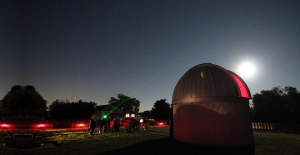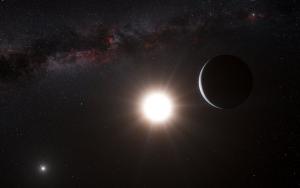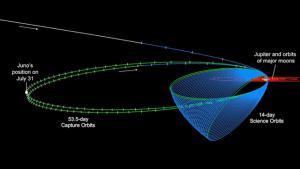
Summer Stargazing Nights
- Where:
- Frosty Drew Observatory
- When:
- Friday August 19, 2016 at 7:30 p.m.
- Cost:
- $1 Suggested Donation per Person
Tonight is Stargazing Night at Frosty Drew Observatory and we may be in store for a bout of great lunar viewing. Forecasts are calling for mostly clear skies with a few passing clouds. Fog may roll in after 1:00 a.m., though the super bright 98% waning gibbous Moon will chase us out before the fog does. The skies may be a bit hazy, but Saturn and the Moon will look fabulous in our telescopes.
We will open the Observatory, Sky Theatre, and Nature Center at 7:30 tonight. In the Observatory, telescopes will showcase the rings of Saturn and the cratered lunar surface. Telescopes on the lawn will feature wide field views of the Moon as well as a handful of binary stars. The Sky Theatre will feature a showcase of celestial objects we photograph at Frosty Drew Observatory and will offer a safe haven from the twilight mosquito feast. In the Nature Center, Frosty Drew Naturalist – Thaxter Tewksbury will enlighten you with the daylight side of Frosty Drew. We will stay open and rocking the skies until midnight.
Overall, tonight is not the night for Milky Way hunters. The super bright 98% Moon will significantly outshine any hint of the Milky Way overhead. But if the Moon is your digs, then the luna-tic inside will revel in the brilliant Moonlight. So add a little awesome to your Friday night list of things to do with a visit to Frosty Drew Observatory and have a night out with the Moon.
-------------------------------------------------------------------------
Weekly Happenings
Scott MacNeill
This past week, astro and science news outlets have been flirting with a story that rumors the existence of an Earth-like planet around Proxima Centauri, the closest star to the Solar System. Residing at 4.25 light years distant, Proxima Centauri is a red dwarf star and possibly a third component of the binary star system - Alpha Centauri. Though largely rumors at this point, a German magazine – Der Spiegel, published a rather hyped up article stating that the European Southern Observatory (ESO) has identified a rocky planet that is in the habitable zone around the red dwarf. ESO is not confirming nor denying the discovery and are offering no comment at this time. Note, that “Earth-like” doesn’t mean it’s crawling with coffee drinking, high-fiving aliens, it just means the planet has an orbit around its parent star where temperatures are just right for liquid water to potentially exist on the surface; a requirement for life. If true, this would be an awesome discovery because of how close it is to us. Nearly all “Earth-like” planets already discovered are hundreds to thousands of light years distant. The hint at such a planet so close is a fabulous prospect, though refusal to comment is not a confirmation of discovery. ESO will make an announcement before the end of the month along these lines. So keep an eye out for any updates / debunks to this rumor and don’t freak out yet.
Remember the little spacecraft that acquired orbit around Jupiter this past Fourth of July? That was the NASA Juno mission and the arrival at Jupiter was all the rage. Well Juno really fell off the media hype wagon since. Probably because, upon arrival, it inserted itself into an obit that takes 53.4 days to complete one revolution. Juno will complete two of these super long orbits, called “capture orbits” before closing into its planned science orbit of 14 day revolutions. Though the mission has been quiet, Juno reached its furthest point from Jupiter in its current orbit on July 31st, called “apojove” at a distance of 5 million miles from Jupiter. Since then, Juno has been quickly approaching Jupiter and will arrive at its closest point in its current orbit on August 27th at a mere distance of 2,600 miles, just skimming Jupiter’s cloud tops. Unlike Juno’s arrival at Jupiter, when all science instrumentation were disabled, this time Juno will be ready to rock, with all instruments collecting data on Jupiter during this close approach. This will serve a tasty treat for all those Jupiter geeks hungry for data and will make for a great test run in preparation for the start of the science mission this October. So get excited again and check out the NASA Juno mission
-Scott


